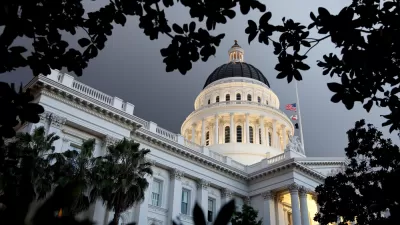Environmental advocacy is not enough. Environmental and social justice must play a role in California's legislative effort to battle climate change, opine two professors from UC Berkeley and USC in the San Francisco Chronicle.

California nearly ended its historic, decade-long legislative effort to fight climate change that began with the passage of the California Global Warming Solutions Act of 2006. Instead, "Gov. Jerry Brown cemented an unexpectedly strong alliance of labor unions, grassroots 'environmental justice' organizations and environmentalists," opine Carol Zabin, who chairs the Donald Vial Center on Employment in the Green Economy at University of California, Berkeley, and Manuel Pastor, professor of sociology and director of the Program for Environmental and Regional Equity at the University of Southern California, in this op-ed for the San Francisco Chronicle.
In the face of business opposition, these groups helped pass SB32, a bill to require a 40 percent emissions reduction by 2030, by pairing it with a companion bill, AB197, designed to ensure that emissions reductions and job benefits actually occur in less advantaged neighborhoods.
Zabin, Pastor, Abigail Martin, and Jim Sadd authored research released on September 13 on the pairing of labor and environmental justice groups to fight climate change in California.
According to Zabin and Pastor, "Research has shown that incentives for residential rooftop solar and clean cars have gone disproportionately to more affluent people, forcing those left out to advocate separate programs for renters and low-income drivers." On the labor front, unions question whether jobs in the "low-carbon sector" will pay as high as those in "conventional energy infrastructure."
The climate equity agenda was also key to a $900 million agreement struck between Gov. Jerry Brown and legislative leaders on how to spend cap-and-trade revenues in the Greenhouse Gas Reduction Fund.
Per the governor's press release of Sept. 14:
"These cap-and-trade investments will help spur innovation of all kinds to curb carbon pollution," said Governor Brown at a signing ceremony in downtown Fresno, where cap-and-trade proceeds are helping to improve bus rapid transit services and access to affordable housing.
Zabin and Pastor acknowledge that "[s]ocial equity and emissions reductions are not always easy to pair."
One example is community-scale solar, which involves decentralized, midsize solar projects that are larger and thus lower-cost than solar rooftop on individual homes. Community solar can be located in poor areas, does not require homeownership, and can be contracted to include prevailing wage standards and entry into apprenticeship programs for local residents.
Engaging workers and disadvantaged communities will be key to future climate legislative successes, conclude Zabin and Pastor.
Related research:
- California Environmental Justice Center: New Report Highlights Equity Flaws in California’s Cap-and-Trade Program, September 14, 2016
- UC Berkeley Labor Center: Advancing Equity in California Climate Policy: A New Social Contract for Low-Carbon Transition, September 13, 2016
- UC Berkeley Labor Center: The Link Between Good Jobs and a Low Carbon Future, July 12, 2016
Related on Planetizen:
Social Equity: The Missing Leg of the Three-Legged Stool of Climate Action, March 13, 2016
FULL STORY: Embrace equity to win on climate goals

Pennsylvania Mall Conversion Bill Passes House
If passed, the bill would promote the adaptive reuse of defunct commercial buildings.

World's Largest Wildlife Overpass In the Works in Los Angeles County
Caltrans will soon close half of the 101 Freeway in order to continue construction of the Wallis Annenberg Wildlife Crossing near Agoura Hills in Los Angeles County.

U.S. Supreme Court: California's Impact Fees May Violate Takings Clause
A California property owner took El Dorado County to state court after paying a traffic impact fee he felt was exorbitant. He lost in trial court, appellate court, and the California Supreme Court denied review. Then the U.S. Supreme Court acted.

California Grid Runs on 100% Renewable Energy for Over 9 Hours
The state’s energy grid was entirely powered by clean energy for some portion of the day on 37 out of the last 45 days.

New Forecasting Tool Aims to Reduce Heat-Related Deaths
Two federal agencies launched a new, easy-to-use, color-coded heat warning system that combines meteorological and medical risk factors.

AI Traffic Management Comes to Dallas-Fort Worth
Several Texas cities are using an AI-powered platform called NoTraffic to help manage traffic signals to increase safety and improve traffic flow.
City of Costa Mesa
Licking County
Barrett Planning Group LLC
HUD's Office of Policy Development and Research
Mpact Transit + Community
HUD's Office of Policy Development and Research
Tufts University, Department of Urban and Environmental Policy & Planning
City of Universal City TX
ULI Northwest Arkansas
Urban Design for Planners 1: Software Tools
This six-course series explores essential urban design concepts using open source software and equips planners with the tools they need to participate fully in the urban design process.
Planning for Universal Design
Learn the tools for implementing Universal Design in planning regulations.

























